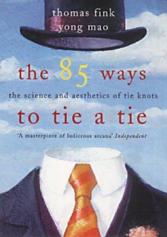The 85 Ways to Tie a Tie
 |
|
| Author | Thomas Fink and Yong Mao |
|---|---|
| Publisher | Fourth Estate |
|
Publication date
|
November 4, 1999 |
| ISBN | |
| OCLC | 59397523 |
The 85 Ways to Tie a Tie (ISBN ) is a book by Thomas Fink and Yong Mao. The authors were research fellows at Cambridge University’s Cavendish Laboratory. It was published by Fourth Estate on Nov 4, 1999, and subsequently published in nine other languages.
The 85 Ways to Tie a Tie is about the history of the knotted neckcloth, the modern necktie, and how to tie both. It is based on two mathematics papers published by the same authors in the journals Nature and Physica A. The authors prove there are exactly 85 ways of tying a necktie, under some restrictions, and enumerate them.
The discovery of all possible ways to tie a tie depends on a mathematical formulation of the act of tying a tie. In their papers (which are technical) and book (which is for a lay audience, apart from an appendix), the authors show that necktie knots are equivalent to persistent random walks on a triangular lattice, with some constraints on how the walks begin and end. Thus enumerating tie knots of n moves is equivalent to enumerating walks of n steps. Imposing the conditions of symmetry and balance reduces the 85 knots to 13 aesthetic ones.
The basic idea is that tie knots can be described as a sequence of five different possible moves, although not all moves can follow each other. These are summarized as follows. All diagrams are as the tie would appear were you wearing it and looking in a mirror.
With this shorthand, traditional and new knots can be compactly expressed, as below. Note that any knot that begins with an o move must start with the tie turned inside out around the neck.
Li beginning.
Lo beginning.
Lo
Ro
Li
Ri
Lo Ri Co T end.
Ro Li Co T end.
Of the 85 knots possible with a typical necktie, Fink and Mao selected thirteen as "aesthetic knots" suitable for use. They made their selection based on three criteria: shape, symmetry, and balance.
...
Wikipedia
